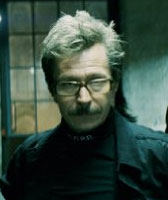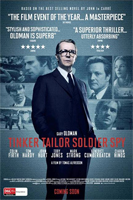Gary Oldman The Darkest Hour
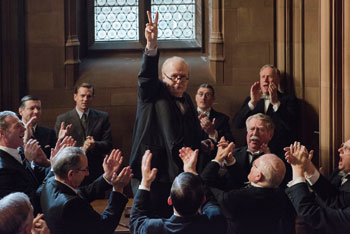
Gary Oldman as Winston Churchill
Cast: Gary Oldman, John Hurt, Kristin Scott Thomas, Ben Mendelsohn, Lily James
Director: Joe Wright
Genre: Drama, History
Rated: PG
Running Time: 125 minutes
Synopsis: Academy Award nominee and BAFTA Award winner Gary Oldman stars for BAFTA Award-winning director Joe Wright in Darkest Hour, a thrilling account inspired by the true story of Winston Churchill's first weeks in office during the early days of the Second World War. Academy Award nominee Anthony McCarten's original screenplay takes a revelatory look at the man behind the icon.
A witty and brilliant statesman, Churchill is a stalwart member of Parliament but at age 65 is an unlikely candidate for Prime Minister; however the situation in Europe is desperate. With Allied nations continuing to fall against Nazi troops, and with the entire British army stranded in France, Churchill is named to the position with urgency on May 10th, 1940.
As the threat of invasion of the UK by Hitler's forces looms and 300,000 British soldiers cornered in Dunkirk, Churchill finds his own party plotting against him and King George VI (Emmy Award winner Ben Mendelsohn) skeptical that his new Prime Minister can rise to the challenge. He is confronted with the ultimate choice: negotiate a peace treaty with Nazi Germany and save the British people at a terrible cost or fight on against incredible odds.
With the support of his wife of 31 years, Clemmie (Academy Award nominee Kristin Scott Thomas), Churchill looks to the British people to inspire him to stand firm and fight for his nation's ideals, liberty, and freedom. Putting his power with words to the ultimate test, with the help of his tireless secretary (Lily James), Winston must write and deliver speeches that will rally a nation. As Winston withstands his own darkest hour, he attempts to change the course of world history forever.
The Darkest Hour
Release Date: January 11th, 2018
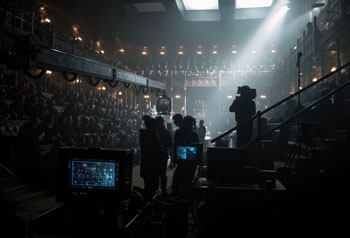 About The Production
About The Production
Words and Context
In dark days and darker nights, when Britain stood alone, and most men save Englishmen despaired of England's life, he mobilized the English language and sent it into battle. The incandescent quality of his words illuminated the courage of his countrymen.
President John F. Kennedy, 1963
"Words can, and do, change the world. This is precisely what happened through Winston Churchill in 1940," marvels BAFTA Award-winning screenwriter and producer Anthony McCarten. "He was under intense political and personal pressure, yet he was spurred to such heights in so few days – over and over again."
McCarten has long held an interest in the legendary statesman's life, and like many he has found inspiration in Churchill's speeches and oratory. His most recent screenplay, the Academy Award-nominated one for The Theory of Everything, explored another great man, Stephen Hawking, whose words changed the world even after he could no longer speak. McCarten found himself gravitating towards the intense period "of May 10th through June 4th, during which Winston turned coal into diamonds."
The linchpins of his original screenplay for Darkest Hour became three speeches that Churchill wrote and delivered between May and June 1940.
It's a common saying that the first few days and weeks on the job are challenging. For this 65-year-old man, being named Prime Minister of Great Britain on May 10th, 1940 came at a time when the stakes could scarcely have been higher. Allied Forces was already at war with Adolf Hitler, and one democracy after another had fallen to his Nazi forces. Britain now stood on the edge of a precipice. The dilemma was, either steel the nerves and be drawn deep into the conflict; or retreat from the war altogether, with inconceivable consequences for British sovereignty.
McCarten clarifies, "The question was whether to fight on alone, perhaps to the destruction of the armed forces and even the nation, or to play it safe – as Viscount Halifax and [outgoing] Prime Minister Neville Chamberlain believed – and to that end explore signing a treaty with Hitler. Winston had to wade into this fray, and he found himself battling the establishment.
"This story is anchored in the past yet it resonates all the way into the here and now. Too often today, our 'leaders' are followers. These decisions made in less than one month's time had global ramifications."
Lives also hung in the balance during May and June 1940, as over 200,000 British soldiers – the UK's entire Expeditionary Force – were trapped on the beaches of Dunkirk, France, awaiting rescue and evacuation.
McCarten's research led him to the minutes of Churchill's War Cabinet meetings. He notes, "These revealed a period of uncertainty, something we don't take into account considering his robust leadership. Winston knew he had made wrong calls in the past, certainly during World War I with the Battle of Gallipoli.
"Pedestals are for statues, not for people, and a close reading of the minutes reveals not only a leader in trouble, under attack from all sides and uncertain what direction to take, but also just how dangerously close a country came to entering into a 'peace' deal with an enemy who, if unchecked, would have reshaped the world forever."
Ultimately, says McCarten, the Darkest Hour screenplay took shape "examining the working methods and leadership qualities and trains of thought. Winston strongly believed that words mattered, and he took pen in hand to help him – and his country – face down a terrifying threat.
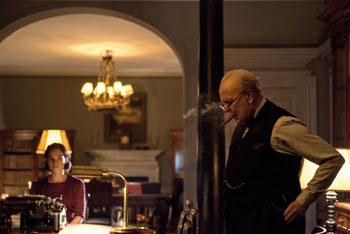 "In the process came the self-willed making of an iconic man."
"In the process came the self-willed making of an iconic man."
Setting himself a concentrated work schedule to mirror the historical time frame, McCarten after eight days had 16 pages. He showed these to Academy Award-nominated and BAFTA Award-winning producer Lisa Bruce, with whom he had made The Theory of Everything, as the project was being completed.
Bruce remarks, "I read it, and at once I realised Anthony was again designing an intimate look at the humanity of an icon. We have all learned about WWII and maybe think we remember more than we do, so Anthony put just enough contextual information into his script; even if you don't know everything about this period you can clearly follow what's going on in the world that Winston orbited.
"With Darkest Hour, although the wit and intelligence he's known for are very much in evidence, you see him in such a different way. What Anthony was focusing on - an extreme moment in time – powerfully conveys Churchill's vision and voice as a leader and his ability to assess what mattered. Churchill was able to tune out the noise and get people behind him, even opposing party members. He got everyone in line with the idea to stand and fight Hitler, understanding the threat and the bigger – much bigger – picture."
She adds that, decades on, "Darkest Hour is timely because we feel a void of leadership now; we want someone to rise to the occasion as Winston did. The title came from his own assessment of this period as the biggest challenge he ever faced. His whole life – which was already impressive – had been leading up to this moment."
As McCarten delivered more pages, Bruce moved to advance the project by bringing it to the attention of their fellow The Theory of Everything producers, Academy Award nominees and BAFTA Award winners Tim Bevan and Eric Fellner of Working Title Films.
Fellner sensed that the story of "a statesman finding grace under pressure" would appeal to one of Working Title's key creative collaborators, BAFTA Award-winning director Joe Wright; the production company and the director had teamed so successfully on, among other projects, Atonement, with its unforgettable World War II scenes.
Wright remarks, "Our relationship has grown and developed. There's always a wonderful can-do-attitude at Working Title: here's the script, here's the director, here's the actors, let's make a movie! And we do."
Fellner's instinct was correct, as Wright found himself "immediately wrapped up in what was a real page-turner, pure drama. I've always considered the Second World War to be the fulcrum of the 20th century. It changed everything.
"If the audience today can engage with an icon of that time as a human being, then his qualities of leadership will be that much more inspiring."
After Wright committed to the project, he worked closely on the script's progress. McCarten reports, "Joe became such a partner in the process; I spent many weeks with his putting my feet to the fire on every line of the script. I must have gone over to his house 20 times, and each time he would greet me with, 'Good to see you! Okay, page one…'
"That thoroughness and testing of every moment truly tightened up the screenplay."
Wright notes, "I envisioned this as a film for the world, not solely for a British audience.
"We've all seen movies about leaders. Thematically, Darkest Hour is very much about doubt, a crisis of confidence. What's so engaging about it is you're with a legend as he rises above the difficulties we have all faced."
Bruce remarks, ""I learned a lot from Joe during the journey to get this movie made. Joe thinks in highly visual terms; he has the whole story in his head and knows where he wants to take the audience emotionally."
Given the intimidation factor for actors of portraying an icon, the filmmakers had anticipated casting challenges.
McCarten reflects, "I was hoping that a revisionist take could be part of the portrayal. I wanted to see an actor completely recalibrate our sense of who Winston was, and I envisioned a Gary Oldman-caliber actor."
Indeed, whenever the Academy Award-nominated and BAFTA Award-winning actor's name is mentioned, it follows that a generation of actors who have aspired to his career comes to mind.
But Fellner thought it best to go to the source – Gary Oldman himself – whom he began his film career with back in 1986 making Sid and Nancy, which also happened to be Gary's first feature film.
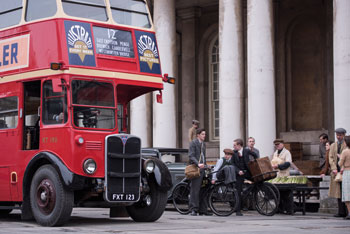 Transformative
Transformative Gary Oldman's longtime producing partner, BAFTA Award winner Douglas Urbanski, comments, "Making a movie about Winston Churchill would defy logic – unless you were examining a specific incident or time frame, which Darkest Hour does.
"When Eric Fellner began to bring people together to discuss the project, we realized that this would be a journey worth taking – a movie that would entertain people but also make them stop and think about the resonance of history."
"When I heard, 'Gary Oldman portraying Winston Churchill,' I thought, 'What a performance that will be to witness,'" says Joe Wright. "He has been my favorite actor since I was a teen: Sid and Nancy, Prick Up Your Ears, The Firm…"
But would an actor who had already incarnated real-life figures ranging from Sid Vicious to Beethoven to Lee Harvey Oswald be willing to take on Winston Churchill?
Oldman reflects, "I had always been fascinated by Churchill as he was truly our greatest statesman. Yet he wasn't someone that I was looking to play. In fact, the prospect of playing him had come my way years ago and I'd rejected the idea.
"It wasn't the psychological or the intellectual challenge that was the hurdle, it was the physical component. I mean, you need only look at me and look at Churchill..."
Even so, he admits, "With who was joining up on Darkest Hour, my inclination became to say yes.
"What I liked about Anthony's wonderful script is that it's not a 'biopic.' It dramatizes a few crucial weeks in our history straight through, so there's no jumping forward or back and no aging."
Darkest Hour held an even more elemental appeal for Oldman, who admits, "I wanted to say those words; Churchill's speeches – which he wrote himself -- are some of the greatest in the English language. He was remarkable because he didn't go in for purple prose, or overload with metaphor or imagery. He could make use of those when needed. But he understood the people he was speaking directly to, and made sure that what he said just went right to the heart of the nation.
"All the while, he was experiencing adversity. His own government didn't want him. There was infighting in the War Cabinet, and Churchill feared for the lives of the thousands of men trapped at Dunkirk. To be under that kind of duress, under that kind of pressure, and to craft some of the greatest use of the English language…it was nothing short of miraculous."
Darkest Hour would put one of Oldman's tenets to the test. He notes, "It all starts with the voice. I had to convince myself that I could sound like Churchill. So I got one of his speeches and a phone recorder and started to experiment.
"Then I dug into written materials outside of the screenplay to learn about the man who took on a tyrant. I wanted to get at the psychological and the intellectual. I wanted to build him brick by brick."
Urbanski notes, "The script only spans specific weeks, yet Gary still wanted to read all about him, sponge up everything he could about Churchill."
Dr. Larry P. Arnn, a Churchill historian and biographer, recommended to Oldman what the actor took as "essential reading. Which was a help, because there have to be 1,000 books about him; you could spend years reading about the man!"
Urbanski comments, "Dr. Arnn and our historical advisor, Phil Reed, would review everything we submitted to them for accuracy. They would also visit the set whenever we asked."
Oldman reports, "I kept at it vocally, and looked at a wealth of documentary footage that revealed a 65-year-old man with so much energy and drive."
Churchill's esteemed career and achievements, including his heroics during the Boer War, are well-documented. But Oldman still found himself in awe as he tallied the man's accomplishments. He enumerates, "Over 50 years in government. 50 books written – he would later get the Nobel Prize for Literature. Decorated in four wars. 500 paintings, with 16 exhibitions at the Royal Academy."
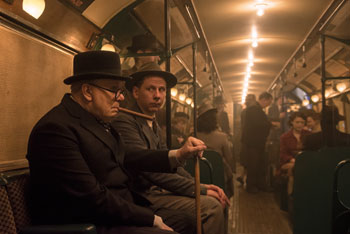 "Had it not been for him, what would our world be like? There's no one to touch him. There's still no one like him."
"Had it not been for him, what would our world be like? There's no one to touch him. There's still no one like him." Oldman felt that he had a handle on the man, yet the physical aspect still was giving him pause. He felt he could not do the role until he could "not only hear the man but feel him physically, the way he moves through space…and, I had to be able to look in the mirror and see him, or at least the spirit of him, looking back at me.
"I felt that Kazuhiro Tsuji was the person – the only person – who could help me get there. In what Kazu does, he's like Picasso."
Acknowledged within the film industry as being in a class of his own when it comes to prosthetics, Tsuji had twice been nominated for Academy Award during his quarter-century as a special effects make-up artist. But he had retired from the film industry back in 2012 to devote himself to contemporary hyperrealist sculpture.
Oldman approached Tsuji personally. The artist remembers, "Gary told me, 'I will be in this film only if you will do it.' I debated it, but I could not say no to Gary. Unlike many, he understands and appreciates the make-up and prosthetics processes."
It was with no small amount of relief that the filmmaking team learned that Oldman had convinced Tsuji to participate and that he would take on the iconic role -- "jumping out of the airplane," as OIdman says.
Tsuji quickly assessed action items for his planning. He admits, "It was daunting, the idea of creating a likeness that everyone their own image of already. The hardest part was that their proportions and their head sizes are totally different. Gary has an oval head shape while Churchill had a more compressed, round face. Gary's eyes are close to each other, while Churchill's are totally opposite. I had to address these restrictions.
"But with the art of make-up, when you have an actor putting the soul into it, he can become the person that we intended to create."
The work on the prosthetics, make-up, and hair required creativity. Early on, everyone realized they needed to find "something that was a hybrid, like a cross-pollination," says Oldman. "It needed to be both Churchill and Gary; the face had to be something that I could work through and with."
It took six months of development and testing for them to achieve the right balance: fitting, sculpting, applying, adjusting, adding and taking away. The labor-intensive process evolved while McCarten continued revising the script and Wright continued his own research and convening key crew members.
Tsuji took casts of Oldman – life casts, full body casts, and head casts –"and we did five make-up tests until we found the design that would work. As a director, one has to have keen eyes, but Joe Wright has really keen eyes and he helped guide us."
Marveling at the process was make-up and hair designer Ivana Primorac; the six-time BAFTA Award nominee is one of Wright's favored collaborators, and had been recruited by the director early on for Darkest Hour to, as she says, "design everyone else's look.
"Churchill's silhouette is so particular – the world knows it –that no actor can be playing him without having that. Gary needed the silhouette to embody Churchill's physicality in speech and movement. Little by little, the transformation started to happen – and at every stage, it was fantastic. What Kazu accomplished with Gary is incredible; I had never seen anything like it."
The life casts had yielded a negative mould which was then used to make a "positive" mould. With real-life photographs and videos of Churchill close at hand, Tsuji then sculpted Winston's features in clay on top of the positive mould. Next, he "made a mould of the likeness and cast silicon rubber in that mould and applied it onto Gary's face. We also make a wig and hairpieces to render the hairstyle. That's how we designed Gary as Winston."
Since this prosthetic make-up was made from silicone, a pliable substance that had special fluids added to make it softer, the result was a lifelike and skin-like texture that, when applied to Oldman's face, would respond to his facial movements so that he could be completely expressive through the make-up.
Certain areas were kept free of prosthetic skin, most notably Oldman's forehead and lips; testing had revealed that prosthetics for both would make it difficult to read facial expressions and impede the performance. To synch up with Oldman's facial expressions, the prosthetics could not be even a millimeter out of place.
Tsuji also had constructed for Oldman "a foam body suit, which you might call a 'fat suit' except that it's light. This helped not only the body shape but also the posture."
By the time production began in the fall of 2016, the full daily application was down to an exact science – one that took up to three-and-one-half hours daily, which helped extend Oldman's workdays to 18-20 hours in total. "I would be in the studio at 3 A.M. for the prosthetics and make-up," he remembers. "The costuming would take another half-hour, up to when the crew arrived at 7."
It all would have taken even longer had Oldman not taken the proactive step of having his head completely shaved so no hair would need to be "masked."
He remarks, "I had David Malinowski and Lucy Sibbick working with me every day, painting and applying everything per Kazu's instructions. What an incredible team!"
The duo would use the natural markers of Oldman's face to guide them –neck, eyes and mouth – as each line was mirrored on the inside of the prosthetic mask from the original cast; Oldman's face became the map for the application of Winston's.
"The headpiece was so soft," Malinowski reports. "It was like holding a pair of tights with baked beans in it, this floppy thing you're trying to put onto the face. If it wasn't in the right place it would buckle and crease.
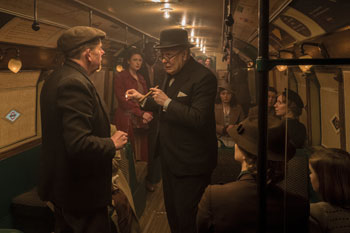 Oldman placed great faith in the daily applications, because once they were complete he could fully concentrate on his performance. To that end, Primorac and her unit kept all make-up checks to a minimum; they were also sensitive to how their lead actor was carrying about half his own body weight in prosthetics and padding.
Oldman placed great faith in the daily applications, because once they were complete he could fully concentrate on his performance. To that end, Primorac and her unit kept all make-up checks to a minimum; they were also sensitive to how their lead actor was carrying about half his own body weight in prosthetics and padding. Removing the prosthetics took as much as two hours daily; it could never once be torn off with a movie-style flourish because that would have damaged Oldman's skin.
Wright remarks, "While we were shooting, it was all real to me. I would completely forget that Gary was wearing any prosthetic make-up at all."
The prosthetic skin often had to be touched up by Malinowski, as the ruddy redness of Winston's face was a delicate latticework of thread-thin veins. The painting process would start with the prosthetic skin as a canvas with a base color of silicone, from which different skin tones, working with the sculpted contours of the face, would be enhanced or played down. Each and every mole on Winston's face would be delicately painted on. Once the skin tones and moles had been added, Malinowski would take the finest of paint brushes to paint hundreds of delicate red-purple lines to approximate the veins.
Customized efforts had to readily reflect the time of day or night as well as the physical state of Winston as dictated by a given scene – down to shaving rash.
Malinowski notes. "We tried to create a character who looked like the real thing. We didn't want people to look at the screen and see the make-up. With digital lensing, the camera can see more, so when you're putting on detail you have to ensure it's as close to life as possible."
The 54-day shoot necessitated at least that number of complete prosthetic sets. That it would be every day without letup for Oldman and the make-up, hair and, prosthetics team would have daunted everyone but for the commitment and patience they all shared.
Tsuji flew across the Atlantic to visit the set several times. He would find himself "not so much looking at Gary as listening to how he put the voice of Winston into his portrayal. What's great has been to see the likeness and then hear the voice come out."
Urbanski marvels, "Gary towers as Winston. Although they are completely different historical figures, his portrayal put me in mind of George C. Scott in Patton. Your jaw drops when you take in the performance.
"Gary's gifts of concentration were such that he would be on the set every day with more energy than anyone; he should have had the least, but instead he was carrying other people along."
"Ultimately," concludes Oldman, "This was the hardest job I've ever been on as an actor.
"Yet it was the most freeing. I couldn't wait to get to work and be Winston. I'd come in every day and think, 'I am so fortunate to be doing this.'"
Speak and Dress the Part
The speeches in Darkest Hour that Winston Churchill made in May and June 1940 are ones have never lost their power or iconic status, nor their ability to inspire. One of the most influential orators of the 20th century, his speeches that mobilized a nation continue to have quotes lifted, regurgitated, and adapted. His words transcend time and place – and now, cyberspace; visit any quotations site on the internet and Winston's words will be prominent.
Joe Wright states, "With Darkest Hour, we are depicting exceptional speeches and the exceptional circumstances that shaped their writing.
"What's not always recalled by people is that Winston started out as a journalist. Writing was his first great talent, one that would serve him well."
Anthony McCarten adds, "He was a writer before he was anything else, and his words formed an enduring legacy."
While Gary Oldman's months of preparations for the role had started with the voice, colleagues were nonetheless startled when the actor arrived on location speaking in Churchill tones well-honed in everything from accent to dialect.
Oldman had noticed something that had eluded many a trained ear. The actor reports, "In listening to speeches he gave – not just the ones we show in the movie – I discovered that Winston had a lisp. He also had a nasality to his speaking, an adenoidal sort of voice. I had to decide when to play those up and when not to."
Wright knew of the track that Oldman had been on, but kept it private as part of the trust between director and actor. Oldman had sent Wright some of the early recordings to gauge. Wright remembers, "I was in the UK and Gary was in L.A. He would record himself delivering one of the speeches, in his hallway so that he would get the right kind of acoustics and echo, and he would mail them to me. I felt I was listening to Churchill.
"Yet it wasn't an impersonation. Gary got at what informed the way Winston spoke."
Also vital to Oldman in crafting his portrayal was "the costume detail. It's such a personal thing because it's what the actor touches."
While Oldman was working from within through the prosthetics and the voice, costuming for him would be by nature externalized; here, too, continuity and attention to aesthetic detail remained front-of-mind for the filmmaking team.
Academy Award winner Jacqueline Durran, a veteran of Wright's films, would be costuming Oldman for the first time since Working Title's Tinker, Tailor, Soldier, Spy, and with a very different physicality.
"I trust her implicitly and she is a delight to work with," says Oldman. Wright adds, "Jacqueline, bless her, approached Darkest Hour with the same passion and enthusiasm that she did our other movies together – even though this meant a lot of men in dark suits!"
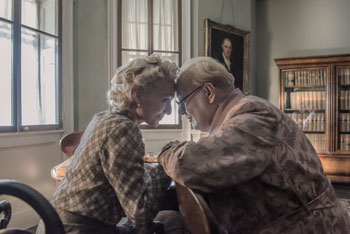 In fact, Durran devoted extra time to working with Oldman, Wright, and Kazuhiro Tsuji on Darkest Hour, spanning six months even before filming began.
In fact, Durran devoted extra time to working with Oldman, Wright, and Kazuhiro Tsuji on Darkest Hour, spanning six months even before filming began. Durran remarks, "When it came to dressing Winston Churchill, the key was to look closely at what he wore and try to replicate that, accurately.
"What I was keen to do was to give Gary the tools to be the Winston that he wanted to be, and to get the imagery Joe needed."
Oldman reminds, "There were those very specific things: the cigar, the watch, the ring, the spectacles, and the hats – he was a hat man."
Churchill's hats were made and supplied exclusively by Lock & Co. Hatters, the world's oldest hat shop. Founded in 1676, their chapeaux have adorned everyone from Lord Nelson to David Beckham. The production went straight to the source. "It was like visiting history," says Oldman.
Durran notes, "Gary worked the hats into his characterization. He has a Homburg, he has a Cambridge, he has a top hat. There were also a naval cap and a fez, but we ended up not utilizing those."
For suits, the production sought out Churchill's original tailor. Founded in 1806, Henry Poole & Co. Tailors of Savile Row "made his clothes. Wearing these felt more tactile for me in portraying him," notes Oldman.
Continuing to outfit Oldman with what Churchill sported, the cigars were Cohiba Siglos and the pocket watch was made by Montres Breguet. The shoes came last, and proved to be the only exception to the rule; they had to be custom-made, as Churchill's original supplier was no longer in existence.
Oldman muses, "It was like a fighter getting ready with the wrapping of the hands, the rituals of getting ready for the battle. Once the face was on and the suit and the clothes, it was all there. It was Winnie."
Looking and sounding the part can take an actor only so far. The litmus test comes in performance.
On the set, Lisa Bruce found she "had chills. At every moment, I felt like I was standing with the real man. What Gary brings to the portrayal – through what he does with his eyes, his posture, his movements – creates Winston in a profound way.
"The incredible make-up and prosthetics bring you to the front door. But it's Gary Oldman who walks you inside to Winston Churchill."
Wright found that communication with his star took on surprising dimensions. The director states, "On Darkest Hour, Gary was my partner. Because he is a director himself – Nil by Mouth is an extraordinary piece of work – I have been able to talk with him about the mechanics of filmmaking in a way that one can't usually with actors.
"Coming into this, I did consider that he might just do his thing himself and I'd get on with everything else. But Gary is a great collaborator. He wants to have discussions, and he wants to take direction. So our making Darkest Hour together became truly exciting."
Oldman adds, "There have been movies I've worked on where I hadn't even met or spoken to the director until I walked onto the set. So it was lovely to be working with Joe, who was so thorough – from working on the script aloud early on to the atmosphere that he creates once on the set. Joe had a vision for Darkest Hour."
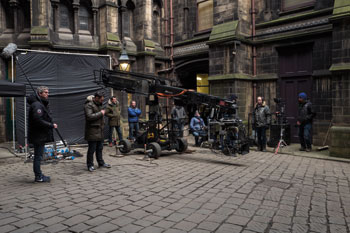 The Women Behind the Man
The Women Behind the Man As the saying goes, behind every great man is an even greater woman. The most important woman in Winston Churchill's life during those four intense weeks in the spring of 1940 was his wife of 31 years – and counting – Clementine, known as Clemmie. Marrying her was, he said, his most brilliant achievement.
His confidante, his conscience, and his critic, Clemmie was the one person Winston trusted above all others. Joe Wright reveals, "Clemmie was very much Churchill's partner in policy as well as in domestic life. She was more liberal than Churchill and as such often argued for the liberal cause. Sometimes he listened to her, not always. But she was integral to his decision-making process."
To portray Clemmie, the role called for someone who could convey class and distinction, intelligence and sharp wit. "Who better than Dame Kristin Scott Thomas?" says Eric Fellner.
Wright agreed that the Academy Award nominee would be a perfect match for Gary Oldman on-screen. "You listen to Kristin whenever she speaks," he remarks. "I've always wanted to work with her, and have probably had a little bit of a crush on her since I was a teenager."
Scott Thomas had admired Wright's Pride & Prejudice and Atonement, "and working with Joe was exactly how I had imagined; he will let actors experiment, and is open to all sorts of ideas, not completely fixed on one way or another."
She saw Clemmie as "a pillar. She and Winston completely adored each other – and they had the most fantastic rows.
"How he managed in those weeks in May and June to instill a sense of patriotism, bravery, and pride in Britain was extraordinary."
Like Oldman, she found the "material to do homework with quite daunting. I received this box full of books from the production, and every single book was so thick. But I plunged in, and doing the research was fascinating.
"I was also conscious of how people have played Clemmie before and done their versions. I had to find my own way through, my own interpretation and vision of Clemmie."
Once again, it was Winston's words that led the way. Scott Thomas reports, "Churchill says in one of his letters that he wouldn't have been able to live through the war without Clemmie by his side. It was clear that she was very supportive yet had very strong ideas about politics and about what should be done in the world and how things should be run – and she would tell Winston so."
Lisa Bruce comments, "Both emotionally and intellectually, Clemmie and Churchill were equals. Nobody else could see past the veneer of Winston in the way that Clemmie could. Kristin was quite aware of that, and she brought that into her scenes with Gary. It was like a dance for the two of them, and watching them together was a joy."
Oldman states, "I believe Kristin's Clementine is definitive. It is a wonderful characterization. I think she and I have good chemistry in Darkest Hour."
Scott Thomas offers, "I would completely forget it was Gary. We were just Winnie and Clemmie."
Responding to what she saw as a "powerful story of our history, of everyone's history, that we should remember and reflect on," rising star Lily James joined the Darkest Hour troupe to portray the character of Elizabeth Layton, Churchill's personal secretary.
James was glad to be "doing a film where I'm not playing a love interest, and not about romance. But there is a beautiful bond that develops between Churchill and Elizabeth."
Screenwriter Anthony McCarten had taken inspiration from the real-life Elizabeth, who published memoirs detailing her years with Churchill under her married name Elizabeth Nel.
McCarten scripted the character to afford the audience a more intimate ringside view of a man whose world was by necessity far removed from the everyday, and Wright carried this motif over to filming the scenes of secretary and employer together.
"Elizabeth is like the eyes of our movie," explains Wright. "I wanted no blockage between Lily and the audience. Her point of view on the story is an accessible one and leads into what for me is an important aspect of this story: Winston's disconnection with, and then restored and strengthened connection to, the British people.
"To an extent, he lived in a fairly rarefied environment. In a time when true leadership was essential, he had to step out of his bubble and connect with the man and lady in the street. Only by making contact with ordinary people and hearing their concerns could he best understand the repercussions, the effects of the enormous decisions that he was making."
James reports, "I loved reading Elizabeth's autobiography. She knew she had a job to do, and a fighting spirit. Her book was just so full of admiration and you can see that she really loved Churchill, as did I think all his inner circle of staff; he was incredibly hard and strict and wanted things how he wanted them, but he had this spirit of generosity and this incredible wit and humor.
"I would barely see him not in full as Churchill; Gary Oldman is so bold and he was really kind to me, as one actor to another."
She adds, "Joe Wright creates an atmosphere on-set where you can get at the humanity of the characters rather than the heaviness of politics and history.
"It all felt very collaborative, creating the character's look with Jacqueline Durran and Ivana Primorac; Joe trusts everyone to work together."
Indeed, as Primorac offers, "It is all linked and we could never do it without each other's input. Joe utilizes us as a team.
 "Lily is a very modern young woman, but we were able to transform her into a more plain woman of the 1940s."
"Lily is a very modern young woman, but we were able to transform her into a more plain woman of the 1940s." All through filming, James kept specific details in mind, particularly how "Elizabeth had to follow him around; even in his car, she would be there with her notepad or typing. I took a few months and learned to type professionally on a vintage typewriter.
"Basically, Elizabeth was on duty at any hour and I had to put myself in the mindset of being a young girl in her early twenties in such close proximity to a genius, working on speeches and telegrams that would change the course of our future."
Durran gave the character more of a clothing arc than others in the film. While Elizabeth initially wears soft pretty dresses, she later is seen more assertively dressed in fitted suits and knit wool as she keeps pace within the charged atmosphere of Churchill's orbit.
Lisa Bruce remarks, "Elizabeth is like this bright daisy coming up underground among these powerful older men. She brings a whole different energy to the story and to the relationship. With her, Churchill can let his guard down a bit; through her, you see elements of him which you wouldn't have otherwise.
"Lily has a naturally inquisitive way about her but she also shows Elizabeth's innocence and how she forged loyalty to Churchill. The real Elizabeth wrote about how tough he was to work with but how inspiring he was and how it was the greatest time in her life, and Lily conveying that enhances the story we are telling."
Contemporaries
Despite his many years in Parliament, Winston Churchill was not seen as a likely Prime Minister. That would seem to have changed on May 10th, 1940, when King George VI named him to the post – except that when he assumed power, he still had little support from his own party, the Conservative Party (a.k.a. the Tories), or the British establishment.
While he immediately invited the most recent Prime Minister, Neville Chamberlain, and Viscount Halifax (known as Edward) into his War Cabinet, Churchill was well aware that Chamberlain still held sway over the Conservative Party and that Halifax had been the likely choice of many for Prime Minister – including the King.
Emmy Award winner Ben Mendelsohn, cast as the King, notes that "Darkest Hour explores George VI's feelings about Churchill and about the war. It was a time of enormous pressure on both of them, and there was such a narrow path that they had to navigate together.
"I was delighted, but surprised, when I was asked to play His Majesty. I thought portraying an English figure of this stature was a challenge too promising to walk away from."
Lisa Bruce reports, "It was Joe Wright's idea to cast Ben. As an Australian, Ben had to master the accent including incorporating the vestiges of the King's stutter – which he did. Physically, the match was even stronger."
Joe Wright explains, "Right from the beginning I knew I wanted Ben to play this role. I had admired his performance in Starred Up, and I saw how he has this wild energy that can go to an intense point of concentration. There's a lot going on under the surface with Ben, which imparts a charge to the scenes between the King and Winston."
Ivana Primorac notes, "Joe will always choose the best actors for the roles, and Jacqueline Durran and I and our departments will collaborate with the actor to create the character.
"Ben could almost have gone in front of the cameras the way he is, but we needed more of a sense of regalness. We did him up, including his hair, to the proportions of King George VI and that made Ben stand in a different way and move in a different way. He totally embodied the role.
"When you see Churchill and the King together, it's wonderful because Churchill is a very important character and suddenly he seems small –untidy and all wrinkled – and the scenes surprise you."
Gary Oldman remarks, "Colin Firth [playing the role in The King's Speech] was a hard act to follow – but Ben did it brilliantly. He has a very unique take on the King.
"Ben called up Joe and said, 'There's too many r's in my scenes.' He was sensitive to how people who stutter – which we know the King did – avoid certain words in favor of others. Ben had gone through the script with great specificity and what he was proposing made complete sense. So those changes were made to our scenes together."
Mendelsohn offers, "You never want to leave anything behind in what you're doing, in terms of the effort that you bring to it. While I was not setting out to do an impersonation of King George VI, I was setting out to do an interpretation, and there are certain things that one wants to get right.
"It was a great honor to be asked to play against Gary Oldman, as he is an actor's actor. Look, this was the closest any of us were going to get to being in a room with Winston Churchill."
While Churchill and the King's relationship evolved during the spring of 1940, the opposing strategies and opinions Churchill had with Chamberlain, Halifax, and others were documented in the minutes that Anthony McCarten had read; many unfold verbatim in Darkest Hour.
For Wright, the War Rooms scenes "are centerpieces of the movie, and central to the story we are telling. The dialogue in Anthony's script for those scenes was taken from the meetings' minutes, where great drama played out. I wanted to try and stage those scenes in a cinematic way, what with 17 actors in one space. Often people think of cinematic as being sweeping wide shots of landscapes, whereas for me cinema is about the intention rather than the canvas.
"Some of the blocking was done for me – by Winston. He would have people in the War Rooms who opposed him facing him. This prevented them from talking behind his back."
McCarten notes, "On the one side were those in support of appeasing the Nazis and on the other were those urging that the nation stand and fight Hitler. Winston's conflict with Halifax crystallized these arguments, and seeing and hearing them the audience too must consider what the UK and Churchill were up against."
Wright elaborates, "We didn't want to make a film that simply said Churchill was great. We felt that the audience should actually hear the arguments and ponder them. What was essential about Churchill is that he himself would do just that; as a leader, he listened and considered other people's points of view and then made a decision. We show this more than once in Darkest Hour.
"In the scenes, I hope the audience will hear Halifax out and consider his position carefully; if Britain hadn't won the war, might Halifax have been right? Also, Churchill would then not be the hero. Winning a war is made up of so many choices and so much luck, tragic and otherwise."
He notes with relief, "History has proved Churchill right and that is worth celebrating. But in May 1940 there was validity to exploring the avenue of a negotiated peace, not least because Britain didn't have an army any more; the ground force was trapped at Dunkirk, on the other side of the Channel. If they were going to be wiped out the UK would then not be able to defend itself at all."
For Halifax, an aristocrat with deep religious faith, Wright felt he needed an actor who could convey authority and conviction rather than caricatured antagonism. Tony Award winner Stephen Dillane's name came up as a casting suggestion, and the director was intrigued.
"Stephen is a rigorous actor whom I knew could really put across those arguments in a way that would compel an audience to consider them," says Wright. "He conveys moral gravitas, and I do think that he will persuade filmgoers that Halifax might have a point. His was a valid argument."
McCarten comments, "One could never turn a deaf ear to an argument for peace, but Churchill's knowledge of history told him that those countries which surrendered abjectly never came back strongly while those that fought lived to fight again."
To embody Halifax, Dillane worked closely with Primorac – including, as she says, "shaving half his head" – and found in his research that he had his work cut out for him. He notes, "It was difficult to find anyone willing to put in a good word for him. Halifax has become the figure on the wrong side of history, and it's hard to examine that with objectivity rather than with myth-making.
"What was interesting to consider was how and when he believed he could be leader of the Tories [party] and whether there would be military action."
Lisa Bruce reflects, "Stephen brought to bear a studied perspective on the man and did question every aspect of Halifax, the different sides of him. He's put layers into his characterization of Halifax, making a stronger counter to Churchill and making the War Rooms scenes more powerful."
Veteran actor Ronald Pickup stepped in to portray Neville Chamberlain after the passing of actor John Hurt, who was originally cast in the role. "I felt privileged to be in Darkest Hour," says Pickup. "It is a suspense story that is also life-affirming.
"Neville Chamberlain was in favor of appeasement with Hitler, and the House of Commons rejected that and forced his resignation. But he remained leader of the Tories, and still had quite a bit of influence. He wore a uniform, essentially being an Edwardian."
Douglas Urbanski offers, "What Ron brings to the part is a combination of vulnerability and strength. Through his performance, just in his eyes, you see so much in Chamberlain as these weeks progress.
"Many have the idea that Churchill and Chamberlain were rivals. What most people don't know is that Churchill gave a beautiful eulogy following Chamberlain's death before the House of Commons."
Pickup found that acting with Oldman "was both spine-chilling and moving in that Gary somehow embodied Winston, had the life force in his performance. I think he's one of the great actors because he does it without any comment.
"Anthony's beautifully written script was very non-judgemental. Joe kept us away from excesses, and he loves his characters."
Bruce notes that every member of the cast benefitted from Wright's dedication to being "very specific about details. I'd never been on a movie where the director held two weeks of full rehearsal with actors, allowing them to really find who the characters were. Many of the actors spoke about how rare that truly is."
Oldman reveals, "That was 10 weeks for me – an absolute joy, as I'd not rehearsed so much since my stage days."
Bruce adds, "Joe brought in researchers and historians to confer with the actors, organized field trips to different locations, invited into the process Churchill family members...
"He's a different level of filmmaker because of this way of working. It's evident in the final movie because you don't feel like you're watching something simulated; the preparation of his interpretation is exquisite."
Setting the Scenes
The backdrop to Darkest Hour is that of a frayed Britain. WWI had taken its toll on the country's economy and manpower, and two decades on the nation was still not the industrial or military force it had once been – and was girding for further austerity as WWII loomed.
To depict the state of the nation, Joe Wright availed himself of the venerable creative partnership of Academy Award-nominated production designer Sarah Greenwood and set decorator Katie Spencer. He remarks, "We make films as a unit, and Sarah and Katie are vital to that process. After so many films together, we have a great shorthand."
As part of that shorthand, the team engineers sets that are circular because Wright favors that flexibility for his camera and his actors.
Wright gave the duo the guidelines that "London in 1940 didn't look like it does now; it was dirtier and grubbier. So we avoided classic London locations."
Muted yellows, faded blues, frayed sofas, and worn carpets were trafficked in. The interiors of the Prime Minister's base at 10 Downing Street had the color palette dialed down in line with Academy Award-nominated director of photography Bruno Delbonnel's mandate with Wright.
Which suited Greenwood fine; she reveals, "This period can sometimes look a bit twee on-screen. We all fought hard against that on Darkest Hour.
"When it came to depicting the inside of 10 Downing Street, we were lucky enough to find a derelict Georgian house in Yorkshire that we could, to some extent, do with what we wished – including applying the circularity that Joe wanted."
The art department was not asked to make a carbon copy of No. 10 – in part because there is little documentation of how it looked at in 1940. So the team used that to their advantage.
Greenwood smiles, "It allowed us the freedom to create our own – it feels like 10 Downing Street but is nothing like No. 10! The stairs go in the wrong direction, for example."
Buckingham Palace was doubled at another location, Wentworth Woodhouse, an imposing neo-classical house that holds the title of the largest privately owned home in the UK.
Delbonnel lit scenes in the interior through tiny holes because Greenwood and her team "covered the windows with these massive shutters that had only slats. Also, Buckingham Palace is not quite sparkling during those tense times – given the national mood, it is far more subdued."
Reflecting what consumed Churchill's time during the four weeks depicted on-screen, Darkest Hour would be most characterized visually by two hero sets, the House of Commons and the War Rooms – and in these authenticity would be paramount.
The actual War Rooms have been preserved as museum pieces and could not be filmed in. The production did have measurements and photographs taken there. Gary Oldman spent hours taking it all in, and was allowed to sit in Churchill's chair.
For the recreation, months of planning and further research yielded a stunning recreation of the low-ceilinged bunker in which Churchill and his War Cabinet strategized and debated. The set was housed at the UK's storied Ealing Studios, the world's oldest film studio, where such classics as The Ladykillers and It Always Rains on Sunday were made. Nothing was left to chance, not even the type and color of the map pins.
Oldman adds, "The pins were in the right places. It was eerily like the actual War Rooms, certainly among the best-designed sets I've ever been on.
"The detail was staggeringly good; I opened up a couple of books that were 'lying around' and they were remarkable recreations of logs and journals."
Lily James confirms, "It was amazing. I opened up a drawer, and there were sugar rations as well as pencils ground down from use."
Historical advisor Phil Reed curated the real-life War Rooms for 23 years, which he calls "probably the best 23 years of my life." Reed gave his seal of approval to the recreations by Greenwood and Spencer's department. He remarks, "The brick work, the girders, and even the air supply are just like the original. For some elements, the scale had to be different because cameras had to get in and so forth.
"But the atmosphere and the feel, they have gotten so right and brilliantly evoked."
The art unit had overseen the creation of a living breathing hub of 24-hour activity, teeming with banks of phones, growing piles of paper, maps of Europe, and ruffled sleeping quarters. The overall picture is one of organized chaos, as the unit recreated the progress of the underground space rather than its preserved state.
Greenwood offers, "The War Rooms are like an evolving mess -- from which came Churchill's foresight of what to do. They were all down there in a bunker underground, burrowing in – in more ways than one. Joe wanted a guiding sense of 'make do and mend.'
"The dialogue in the script conveys so well their holding explosive knowledge and deciding how much and when to share with the nation."
James offers, "It's a bit of a maze down there, and you can see how people might go stir crazy. Joe and Bruno got these great shots of us that will surprise the audience."
Douglas Urbanski reports, "The art department's spectacular sets had these thick walls – and yet sometimes the walls could be removed so that Joe could get at a different angle, get closer to the characters with Bruno's unique palette."
Wright notes, "Since a good portion of the movie takes place down there, we also wanted this claustrophobic atmosphere, the pressure on the people, but also the sense of perseverance. There's nothing high-tech about the War Rooms and that is all the more impressive when you think of how people were working with quite basic materials. I find that moving as well."
In deliberately and heightened contrast to the hive of activity below, the House of Commons towered above. The recreation of the Commons, as it stood before the London Blitz hit just a few months later in 1940, was a huge set constructed at Warner Bros. Studios, Leavesden, in southeast England.
Greenwood admits, "Building the set allowed Joe and Bruno more leeway. At one point we were going to shoot in the real House of Commons, even though it was latterly rebuilt and wouldn't have been correct as such, but we were told that we – or any actors – couldn't sit on the benches."
Wright laughs, "Only members of Parliament's behinds are allowed on the benches of the Commons! So we had to build our own. We did opt for a richer, deeper, darker wood, making it more Victorian."
Greenwood assesses, "It was a big, tricky set, and [supervising art director] Nick Gottschalk carefully worked out how far we could go – including budget-wise. But it was worth it in the end to give us that scope and scale allowing Bruno to light it and the camera to move within it.
"Bruno is a master with light; he also has a great naturalism to his work, knowing when to let story and performance speak for themselves."
Wright remarks, "The whole script builds towards what happens there –Winston's unforgettable speech on the 4th of June, 1940."
Some 450 background players, representing both Conservative Party and Labour Party members, were costumed from head to toe by Jacqueline Durran's unit. They filled the set to feed off of Oldman's energy – and to give some to him in turn. "Having real people there, not computer-generated crowds, made for very exciting days," remembers Wright, who kept the momentum going between takes by having music including The Beatles' "Hey Jude" played for the crowd.
Urbanski remarks, "The crowds were encouraged to react to Winston's speeches – cheering and making noise."
Greenwood marvels, "There were so many moments when Gary was saying those words and you would be amazed, whether in the bunker or the Commons. You would feel you were there witnessing history being made."
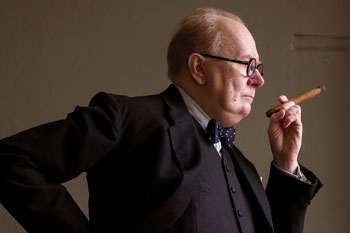 Following the Footsteps
Following the Footsteps In Darkest Hour, when Churchill strides through St Stephen's Hall and doffs his hat and raises his cane to the statues of Prime Ministers past, Gary Oldman is in fact traversing the actual floors of Parliament.
The production requested, and was granted, permission to shoot in the Houses of Parliament, also known as the Palace of Westminster. Darkest Hour is only the second film to have been given access there; the first was Suffragette. The filming approvals process spanned six months.
Security clearances were the highest that cast and crew had encountered on a film shoot, as every piece of equipment and each vehicle had to be checked at a special location; once cleared, they were tracked on a set schedule and strict transport route to Parliament. Any deviation from said route necessitated everyone and everything going back to the starting point; fortunately, that only happened one time.
Houses of Parliament granted Darkest Hour access to St Stephen's Hall and the Palace with no directives to change the script – and with permission for Churchill's cigars to be smoked on-camera.
While interiors of 10 Downing Street were recreated, the exteriors were of the actual No. 10. There too security measures were detailed and comprehensive, and the production was only the second to go where previous films could not; until recently, No. 10 had only ever allowed documentary and news crews to shoot there. Once more, a months-long approvals process yielded access that enhanced the on-screen verisimilitude considerably.
Background security checks on a streamlined crew and vehicles were required, but everyone was thrilled that Bruno Delbonnel's camera would be following Oldman as Churchill through the street and not just framing him at the entrance.
The most somber day for the production came on Remembrance Sunday 2016 as Calais Citadel, under attack in May 1940, was recreated at Chatham's Fort Amherst. 110 background players clad in military uniforms filled out the scene. Wright requested that Max Richter's "Sleep" be played to set the tone. The siege of Calais saw combined French and British forces hold off heavy German attacks for three critical days, allowing for the evacuation of troops at Dunkirk – but at the cost of the destruction of this garrison.
Delbonnel and Wright had mapped out for the scene how the camera would start at a candlelit cross, a makeshift altar, before following the path walked by the Brigadier as he reads the telegram that seals the fate of his men. For the single-take Steadicam shot, the camera operator was attached to wires so that when the camera panned down to read the telegram, the operator was swept up into the air via crane, ascending some 40 feet skyward to survey the scene below. From there comes a seamless transition to the POV from the plane destined to drop a deadly payload.
Wright remarks, "This was my first time working with Bruno, and it was great – in part because he challenged me. He was instrumental to the realization of Darkest Hour."
Film editor Valerio Bonelli, on his first feature with Wright, was matched up early on by the director with frequent composer Dario Marianelli; the Academy Award winner wrote a lot of the score prior to the start of filming. Wright would play Marianelli's compositions on the set while Bonelli would be cutting early and often with the score accompaniment.
Wright adds, "It was perhaps appropriate that for this story about a turning point in our world we had British, French, and Italian creative talents coming together."
Taking Ownership
Anthony McCarten acknowledges that "there are scenes in Darkest Hour where Winston Churchill looks distinctly un-Prime Ministerial."
Joe Wright reports, "Daytime meals for Winston would often be accompanied by a glass of white wine and/or scotch, and because of the hours he kept it was not unusual for him to hold meetings from his bed, or even from his bath. He'd dictate memos for the day from bed and receive visitors and talk about matters of state wearing his dressing gown and nightshirt.
"Finally, no matter what was going on, he would nap every day at 4 in the afternoon – and he kept a very small single bed down in the War Rooms. He was a proper English eccentric."
McCarten remarks, "To get at the man behind the icon, it was important to establish the character traits in Churchill. We're dramatizing specific moments, but everything came from our research.
"Something that history books have not cited often, which is particularly revelatory, is that he was the architect of the Operation Dynamo boat rescue at Dunkirk, where civilian crafts and everyday people were called upon to help get their countrymen home.
"The rescue at Dunkirk was Winston Churchill's idea, and it saved thousands of lives – British and French."
Ultimately, the screenwriter wanted "to push the boundaries of our understanding of him. With regard to Churchill, I feel his three-dimensional nature had become buried under a veneer of history. The more famous a historical figure is, the greater the sense of public ownership in them.
"Winston's weaknesses, foibles, and doubts have been airbrushed out of even the most thorough biographies; he's now often portrayed as this completely resolute character. I think we do him more justice when we present him warts-and-all. In the last 10 years scholarship is starting to reveal other dimensions, so Darkest Hour is part of that new school of thinking."
Phil Reed, OBE, Emeritus Director Churchill War Rooms was historical advisor on Darkest Hour. He comments, "Winston Churchill is often seen as the man who saved his country and the world. This film illuminates that period in his life when he absolutely nailed his colors to the mast and went down a very certain avenue.
"The transformation was from being surrounded by people who didn't trust him or respect him to being the leader who had to place his imprint on the government, on his countrymen, on the world – and he made it."
The Darkest Hour
Release Date: January 11th, 2018
Have You Seen This?
MORE
- Mission: Impossible Fallout
- Glenn Close The Wife
- Allison Chhorn Stanley's Mouth Interview
- Benicio Del Toro Sicario: Day of the Soldado
- Dame Judi Dench Tea With The Dames
- Sandra Bullock Ocean's 8
- Chris Pratt Jurassic World: Fallen Kingdom
- Claudia Sangiorgi Dalimore and Michelle Grace...
- Rachel McAdams Disobedience Interview
- Sebastián Lelio and Alessandro Nivola...
- Perri Cummings Trench Interview

